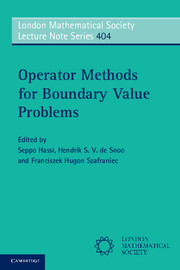Book contents
- Frontmatter
- Contents
- List of contributors
- Preface
- 1 John Williams Calkin: a short biography
- 2 On Calkin's abstract symmetric boundary conditions
- 3 Boundary triplets and maximal accretive extensions of sectorial operators
- 4 Boundary control state/signal systems and boundary triplets
- 5 Passive state/signal systems and conservative boundary relations
- 6 Elliptic operators, Dirichlet-to-Neumann maps and quasi boundary triples
- 7 Boundary triplets and Weyl functions. Recent developments
- 8 Extension theory for elliptic partial differential operators with pseudodifferential methods
- 9 Dirac structures and boundary relations
- 10 Naĭmark dilations and Naĭmark extensions in favour of moment problems
Preface
Published online by Cambridge University Press: 05 November 2012
- Frontmatter
- Contents
- List of contributors
- Preface
- 1 John Williams Calkin: a short biography
- 2 On Calkin's abstract symmetric boundary conditions
- 3 Boundary triplets and maximal accretive extensions of sectorial operators
- 4 Boundary control state/signal systems and boundary triplets
- 5 Passive state/signal systems and conservative boundary relations
- 6 Elliptic operators, Dirichlet-to-Neumann maps and quasi boundary triples
- 7 Boundary triplets and Weyl functions. Recent developments
- 8 Extension theory for elliptic partial differential operators with pseudodifferential methods
- 9 Dirac structures and boundary relations
- 10 Naĭmark dilations and Naĭmark extensions in favour of moment problems
Summary
The theory of unbounded operators, which dates back to the early 1930s, was developed by J. von Neumann and M.H. Stone. Of course the earlier work of H. Weyl on boundary eigenvalue problems and of T. Carleman on singular integral operators should be mentioned as stepping stones for the general abstract treatment. One of the underlying ideas was to put quantum mechanics on a rigorous mathematical foundation. J. von Neumann used a distinction between symmetric (Hermitian) and selfadjoint (hypermaximal) operators and referred to E. Schmidt for this. Once this distinction was made, it was natural to determine all selfadjoint extensions of a symmetric operator (necessarily with equal deficiency indices). J. von Neumann gave such a description for densely defined symmetric operators by means of his well-known formulas. This description requires the knowledge of the deficiency spaces of the symmetric operator. Another approach involving abstract boundary conditions was developed by J.W. Calkin in his 1937 Harvard doctoral dissertation, which was written under the direction of Stone, who suggested the topic. Unfortunately Calkin's work on boundary value problems did not receive the attention it deserved; probably because he never returned to it after his mathematical work related to World War II.
A revival of interest in applications of this approach to boundary value problems is due to M.G. Kreĭn, M.I. Vishik, M.S. Birman, and R. S. Phillips in the 1950s and, later, to G. Grubb, F.S. Rofe-Beketov, and M.L. Gorbachuk.
- Type
- Chapter
- Information
- Operator Methods for Boundary Value Problems , pp. xi - xiiPublisher: Cambridge University PressPrint publication year: 2012



